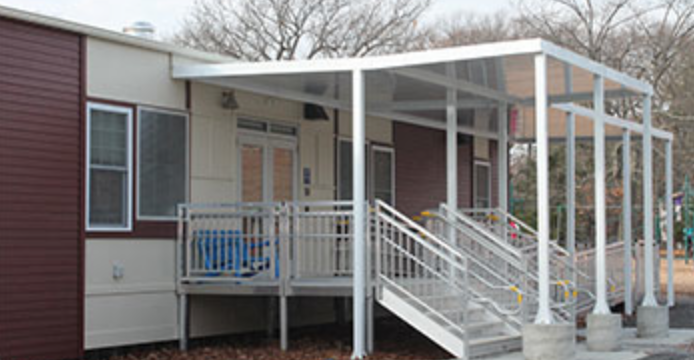Photo: An example of modular classrooms in Needham, Massachusetts.
In the past two years, Belmont town and school officials have used the idiom that the school district has been “bursting at the seams” with the rapid increase in student enrollment – 330 more students – since 2009.
Now that figurative phrase is becoming literally true as the number of pupils continue rocketing upward will likely require the district to begin using modular classrooms – single-story prefabricated buildings most notably used in Belmont to house Wellington Elementary students as the new school was being built – to house the surge of children, according to Belmont Superintendent John Phelan.
Phelan made the observation at two recent meeting in January when the executive summary report of the Belmont Financial Task Force was presented to the public and the Belmont Board of Selectmen.
It doesn’t require a lengthy report to realize that with any increase in enrollment, “the need for increased classroom space is inevitable,” said Phelan.
The first steps to quantify the impact on school buildings began more than a year ago under former Superintendent Dr. Thomas Kingston who established a Space Task Force. One of the first actions taken was hiring a local architectural firm to project the district’s building requirements with the space it had and the estimated number of students coming into the system.
The study concluded for Belmont to keep within its appropriate class-size range, the elementary schools will require an additional class from kindergarten through 4th grade.
“This would result in the need for modular classrooms … by September 2016” for the elementary schools, said Phelan.
The report bluntly stated the Chenery Middle School “does not have enough space to support the current level of student enrollment” and won’t be able to fit the large classes funneling from the four elementary schools in the next five years.
The solution “will result in the need for modular classrooms” by the beginning of the 2016-17 school year.
Nor is the situation at the aging Belmont High School any better. The school is currently “out of space,” said the report, with 31 rooms shared by two teachers and four rooms by three teachers.
With the demand for additional class offerings and “the wave” of enrollment increases coming each year,” the need for space at the High School is becoming critical,” said Phelan.
The “wave” Phelan talked about is evident comparing the 260 students who graduated in 2014 with the 354 students who entered Kindergarten that same year. And those numbers are not seen dropping as “[h]istorical enrollment trends indicate there is little if any, net loss of enrollment over the grade spans.”
In its long-term plan to meet the sky-high enrollment issues facing Belmont, the school district will request hiring an additional 20 teachers over three years beginning in the 2015-16 school year, all dependent on the passage of a $4.5 million Proposition 2 1/2 override sometime in the spring.
A major new initiative by Phelan will be to target eight of the new teachers to reduce the chronic issue of student either sitting in large study halls in the middle school and having idle time at the high school known as “frees.”
The Board of Selectmen has yet to approve or set a date for the override as of Feb. 11.
Even with a successful override vote, space will continue to be a glaring handicap for the schools.
“If you want to increase the number of teachers at the middle or high school to reduce the amount of unstructured, non-educational time … the district will struggle with the ability to do so, without adding temporary space or building more permanent space,” warned Phelan.








You have to keep in mind that school districts are mandated to pay for things now that didn’t even exist in the ’80s and ’90s. So while graduating classes may have been larger back then, class sizes were smaller because more of the school district’s money could be spent on classroom teachers and programs like athletics and the arts. Today, an ever-growing portion of the school budget is required to pay for “unfunded mandates”, which leaves less to pay for all of the things we used to have in the ’80s and ’90s. The bottom line is that schools are far more complicated and more expensive to run now than they were back then, and voters need to be aware of that.
260 students graduated in 2014. how about looking at the 80’s and 90’s graduation class size. They were larger and there education was top tier, Once again the school dept is playing with numbers to scare people into getting what they want. How about a true budget proposed with actual facts. Time after time the school dept holds the town hostage for there own gains at the pupils expense. Salaries are out of control and the staff size keeps increasing. The rest of the town is suffering in all facets due to the schools antics.